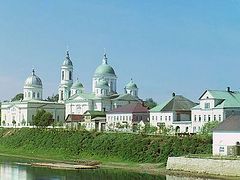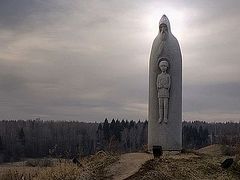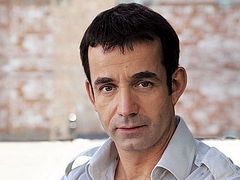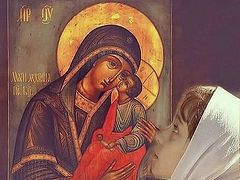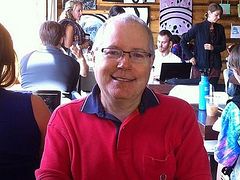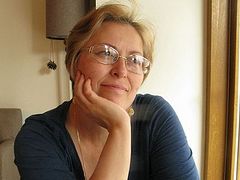Pavel Petrovich Popov is a many-sided, subtle and dynamic personality. He was born to a family of an engineer. After high school he served in the navy. Then he went to Moscow and worked as a mechanic at Lenin Komsomol Automobile Plant. One day he visited a picture exhibition of Ilya Glazunov at the Manege Moscow Central Exhibition Center, and it radically changed his life.’
—You took up painting at the age of twenty-four. It was preceded by service in the navy and work at Lenin Komsomol Automobile Plant in Moscow. Looking back, can you say that it was preordained by God? Did you like painting from your childhood?
—My path towards art was not a very traditional one. I took up painting rather late in life. I was trying to find myself: First I served in the navy, then worked as a cook, next I went to Moscow and got a job under the guest worker quota at Lenin Komsomol Automobile Plant. One day, while walking in the Alexander Gardens, I saw a huge line at the Manege Expositon Center. People were line up to see Ilya Glazunov’s exhibition. This was in 1989.
It was then that I saw paintings, works of art for the first time. Though I liked painting from my childhood, those huge, historical canvases with multiple figures really astounded me. Works by Glazunov and his pupils were displayed at the exhibition. I remember the work by my teacher, Mikhail Shenkov, A Regiment in Ambush. A giant oak tree in the background and a yellow autumn branch that runs through the painting diagonally and hides Russian warriors behind it. There are soldiers young and old and a prince on horseback. All these faces seem to look beyond the viewers and at the viewers simultaneously. The colors were so beautiful, it was done so artistically, brightly and vividly. I was stunned by what I saw and for some reason it seemed to me that I would be able to paint pictures like this one day. From then on I devoted myself to painting.
Following an old Soviet custom, the Lenin Komsomol Automobile Plant had a wonderful art studio. It had a fine collection of still-life and plaster works; there were plaster busts there, as in a specialized college. The teacher was Afanasy Evstafievich Sukhinin, a good artist from Moscow and member of the Artists' Union of the USSR who graduated from the Academy of Arts in St. Petersburg (then Leningrad). He was a pupil of Nikolay Mikhailovich Romadin, Alexander Alexandrovich Deineka, and made friends with Kukryniksy (a creative team of Soviet artists, founded by three painters, namely Mikhail Kupriyanov (1903-1991), Porfiry Krylov (1902-1990), and Nikolai Sokolov (1903-2000)). I got engrossed in meducational studies right away.
Four years later I entered the Russian Academy of Painting, Sculpture and Architecture, which is now situated at Myasnitskaya Street—at the former legendary School of Painting, Sculpture and Architecture, built by the architect Vasily Bazhenov in 1790. As is generally known, among its students were such great Russian artists as Constantine Korovin (1861-1939), Valentine Serov (1865-1911) and Isaac Levitan (1860-1900), and among its teachers were Alexey Savrasov (1830-1897) and Vasily Polenov (1844-1927). It is a school with long history and old traditions. My studies were very interesting. Not only was Ilya Sergeevich Glazunov a good artist, he was also a man with a true love and understanding of art. He trained a bundle of brilliant artists who helped him preserve and revive the school of Russian painting. I was privileged to be their student. I did the first history painting in my second year at the Academy. It was called, Joseph Tells His Dreams to His Brothers. According to the rules of the St. Petersburg Academy of Arts, the themes for paintings were history and the Bible. I had to read a lot to study materials for my paintings. It was then that I began to read the Bible. As a result I gradually integrated into Church life. Eventually the subject of my thesis was the Last Supper. In the history of world art, many artists have tackled this theme. So I set a difficult task before myself. My work was supposed to be unique. And the creative, realistic method of painting from real life helped me.
—Can you tell us how you created the Last Supper in more detail?
—To begin with, for the creation of my composition I invited my friends and acquaintances to the studio, spread a large carpet down and asked them to sit in a circle. There were thirteen of them. When I lit up candles and turned off the light, I saw that it was original and different from anything else. There was a sense of drama. Candlelight projected anxious, large silhouettes of the people onto the wall. It is impossible to invent an effect like this. One can imagine these shadows as a symbol of a waiting for something dangerous. An enormous shadow that hung over these people, who feared and hid. It was suggested by real life sitters. And thanks to real life I completed the task of painting this picture.
—Thus painting helped you become a Christian in an unusual way. Now you had a theme. Please, tell us how you developed it?
—You are right—the Academy helped me integrate into Church life. I am so grateful to both the ever-memorable Ilya Glazunov and the school founded by him for the following: The school encourages students not only to study the history of painting, but also the history of Russia and Biblical history. Some students graduate from the six-year course absolutely transformed, discovering the realm of religion, the realm of Christianity. Likewise, I began to read and study a lot; I wanted to make paintings of Christ and Biblical scenes. I thought that it was the only thing that every artist should do. So I spent several years creating paintings featuring themes from the Scriptures. Thus the pictures “Adam and Eve”, “Mount Sinai”, “Taking Christ into Custody”, and “The Nativity of Christ” appeared. And at some point I made a pause, experiencing a creative crisis. Afterwards I came to realize that I couldn’t continue the Biblical theme without the natural surroundings and that it was impossible to paint Biblical scenes in Moscow. That is, I should go to the Holy Land, to Palestine (like the artist Polenov) to make sketches and collect material for paintings there. Unfortunately, I didn’t have such an opportunity, though I did visit the Holy Land as a tourist. The trip left a lasting impression on me. The nature there is different from ours. It is a scorched desert with scorched ancient cities. All of this is beautiful and scary at the same time. And there is too little water to boot… The impression is reinforced by the fact that this is the land where Christ Himself walked. But you cannot paint anything during a tourist trip. That was (temporarily) the end of my Biblical theme and the beginning of the new, rural one.
—What do the village (the traditional Russia) and the world that you saw in Palestine, in the Holy Land, have in common? What do Rus’ and that ancient Christian world have in common?
—In my view, it is beauty. Like the frightening, austere beauty of Palestine, which is very hot and scorched all over. The desert, stones, and rocks—yellow-red and of other hues. All of this is very beautiful. There is some sublime, tragic image in its nature. It is extremely hard for human beings to survive there. There is lack of water. The situation in villages of Russia’s north is similar—for example, the austere nature of the Vologda region. It is beautiful on the one hand and very austere on the other: There are swarms of mosquitoes in summer, and severe frosts with a lot of snow in winter; so it is hard to survive there. Farmers face a lot of agricultural risks there. People live in izbas [traditional peasants’ log huts] with no sewage system and with only well water. Their diet mainly consists of vegetables, fruit and berries from their kitchen gardens; they depend on their own labor and eat what they grow. They keep cows (and often poultry and livestock). They have to get up at four in the morning there, feed and water their animals, and then go to the field or to the forest. However, people living in the Vologda region are very cheerful and full of life. They thank God for all that they have, for every day of their lives. This similarity alone—the beauty and austerity of nature—creates an artistic image. Imagine dark, almost black fir trees against the background of birch and aspen trees that are turning yellow. There is a special beauty along with expressiveness in this. It amazed me, and I began to paint scenes of Russian rural life. I began to come and stay there for a long time. Then I bought a small house there. I was completely immersed in that life, and this helped me create new, unique paintings. All that I see in Russia’ north and its villages fascinates me to this day, and this is where I derive inspiration for my paintings.
“Red Hill”1 Festival in Serpukhov near Moscow. By Pavel Popov
— Are there any parallels which bring Orthodox Rus’ and the Holy Land together?
—The history of Russian presence in the Holy Land is very long. Russians have the Church of St. Mary Magdalene, the Imperial Orthodox Palestinian Society there, etc. Palestine and Russia have something in common even architecturally. It is remarkable that when I came to Jerusalem and venerated the Holy Sepulcher, I felt as if I were in my native land! I felt at home there. Likewise, whenever I come to the Russian North I feel as if I were in my native town or village.
—In one of your interviews you mentioned that Russian nature is like the hidden Gospel. What do you find in Russian nature which makes it different from other landscapes?
—If you read the Gospel and perceive it as a kind of literary art, its exceptional beauty is worthy of being noted. As you read it you see that its language is just fine and it is written in an unusual manner. Verily, verily, I say unto you (John 1:51)—we don’t speak in this manner. Or take other verses: In the beginning was the Word, and the Word was with God, and the Word was God. The same was in the beginning with God. All things were made by Him; and without Him was not any thing made that was made (John 1:1-3). They are so beautiful! And if we take the Psalter, we find the following there: Have mercy upon me, O God, according to Thy loving kindness: according unto the multitude of Thy tender mercies blot out my transgressions (Ps. 50:1) and further through Psalm 50. Or Psalm 90: He that dwelleth in the secret place of the most High shall abide under the shadow of the Almighty. I will say of the Lord, He is my refuge and my fortress: my God; in Him will I trust (Ps. 90:1-2). It sounds so beautiful yet tragic. Nobody can avoid sorrows in this life. In one of the morning prayers we read: “We bless Thee, O God most High and Lord of mercies, Who ever workest great and mysterious deeds for us, glorious, wonderful, and numberless…”
Let us take as an example the life of the world-famous Russian landscape painter Ivan Shishkin (1832-1898). In his lifetime he was beloved as a brilliant artist. But few people know what trials this man experienced. First it was his father’s untimely death, which was followed by the deaths of his wife and two sons. These tragedies left Shishkin with his daughter alone. He was unable to work for a year and would “drown his sorrows in drink”. A year after those events he painted his famous work, “Rye”. If we look at it attentively, we will see the trunk of a dead tree in the background. It is supposed that the painter depicted himself in this way. Soon after that, Ivan Shishkin remarried. But his second wife died prematurely too, leaving him with a baby girl on his hands. Vasily Ivanovich Surikov (1848-1916), one of the greatest Russian historical painters and author of oil paintings about Russia, experienced the loss of his spouse as well. Though Boris Kustodiev (1878-1927) was one of the most positive painters of his time, from 1916 on his legs were completely paralyzed. Tragedy and beauty usually go together. Russian nature, like the Gospels, contains both beauty and tragedy at the same time. In the Russian North, for instance, if you don’t have firewood, you can freeze to death in winter.
—Why did you decide to paint a portrait of Sergey Yesenin?
—It was made to an order of Yesenin Museum of Moscow. Since painting a portrait of Yesenin with a tobacco pipe seemed not interesting, I wanted to create something special and unique.
I had been pondering over the subject for quite a long time until I saw “prokhodka” (march, stroll) in my Russian village. It is a kind of outdoor festivity in the village, when men and women are dressed in traditional Russian costumes, with an accordion player walking at the head. So the procession first walks in one direction while singing, then turns back and marches in another direction with songs. So this solemn procession is called a “prokhodka”. When I saw our traditional Russian “prokhodka”, it occurred to me that I should depict Yesenin in it. That is, as a participant of this village march. I found a man who somewhat resembled Yesenin in outward appearance. He sat for my portrait, wearing a traditional Russian shirt with a talianka [a single-row button accordion] in his hands. Today talianka is a rare instrument and few people can play it.
But let us return to our subject. This wonderful picture was created. Thanks to that custom painting I began to read Yesenin’s poetry and discovered that though he was a simple village guy, God endowed him with a great talent. The images are so poignant:
Hey there, Russia, mother land,
Huts like icons in their frames…
Eye can’t reach its ends and edges—
All-blue skies beguile your gaze.
“All-blue skies beguile your gaze”. He saw things with the eyes of a painter! There is the following line in his poem, “A Dog Song”:
At this, the dog’s eyes went down,
Like golden stars, into the snow.
—Where can your paintings be found now?
—Some paintings can be found in my studio. In addition, an art exhibition is being held in the village of Verkhovazhye in the Vologda region where I brought some of my paintings. You can see Yesenin’s portrait at Yesenin Museum. The Battle of Kulikovo can be seen in the town of Kolomna near Moscow. You can also visit my website: http://ppopov.ru/.
—What will your next theme be about?
—In his day, Vasily Dmitrievich Polenov used to say that if art has no beauty and no goodness, it is worthless. And Mikhail Vrubel (1856-1910) used to say that an artist must awaken his contemporaries by majestic images of the spirit. I absolutely agree with both of them. I hope I will be able to paint many new pictures. One can grow in painting all one’s life. And this process is unending. It is the process of knowing the world through colors.














